The MGA With An Attitude
REPACKING A MUFFLER -- EX-103
While a stainless steel exhaust system may be forever, glass pack mufflers are not. Having replaced mine three times (under warranty thank goodness), and having blown the stuffing out for the fourth time, I finally decided it might be easier to repack the thing rather than replacing it. So I hatched a plan, and here's how it goes. Get the jack stands.
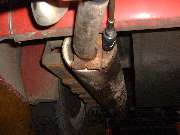
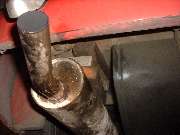
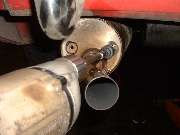
As the muffler hangs in the car, access space for getting in with a hole saw is less than ideal. The left side of the muffler is also rather obscured in line with the bumper overrider. So it was time to R&R the rear hanger to drop the muffler down a bit for easier access. I stacked a few boards between the muffler and the boot floor to lower the muffler appropriately without moving the center pipe hanger. Then I marked the intended locations for the holes, center punch, drill a small pilot hole, drill again for 1/4 inch guide hole, and use the 1 inch hole saw to open a pair of access ports in the back end of the muffler. That was followed by touching off small burrs (inside and out) with a spherical stone in a high speed hand grinder.
The fiberglass to be used is simple building insulation, the same stuff you might install in the walls of your workshop. Off the roll it is 3-1/2 inches thick and 15 inches wide. In the end I used 33 linear inches, which is exactly 1 cubic foot (as it would be fluffy in the walls). The muffler is 4-3/4 inch ID, minus the 1-1/2 inch OD through pipe, and 22 inches long, which works out to be 0.2 cubic feet. So when firmly stuffed the fiberglass is packed about five times more dense than when used for building insulation.
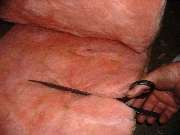

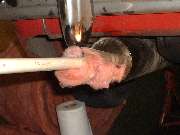
To facilitate the act of stuffing I formed a long narrow funnel out of thin cardboard from one side of a cereal box. This piece was about 7x12 inches. Wedges about 1-3/4 inch wide were cut from each side to make it 7 inches at the wide end and 3-1/2 inches at the narrow end. This is rolled around a small tube (in this case a 5/16 inch fuel hose) to make it conform to being round. Then the small end is adjusted to a bit less than 1 inch diameter, and the larger end to about 2 inches (or a smidge more), and the side seam is taped up to form the funnel. When the small end was a little too small, it was easy to trim it back a bit with scissors to make it just the right size to fit into the 1 inch diameter hole in the muffler.
For a ram rod I found a piece of 3/4 inch PVC plastic water pipe (7/8 inch OD) about 4 feet long. 1/2 inch copper pipe or 3/4 inch wood dowel would do as well. In use the 7/8 inch OD tube was a bit on the large side, but serviceable.
The picture of stuffing fiberglass through the funnel is a little deceptive. It turned out to be easier to use smaller pieces of wadding, and more of them. It was similar to eating cotton candy. I separated the thick bat of building insulation into thinner sheets about an inch thick, then pulled off small bite size pieces to stuff into the funnel. Gloves are a very good idea here, as the fiberglass can be quite itchy on bare hands. After a short test run I recruited the help of my 15 year old son. I sat and stripped and stuffed the little bits of wading into the funnel while he worked the ram rod, and with about 20 minutes of fiddling the job was done.
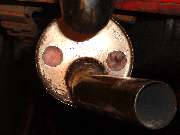
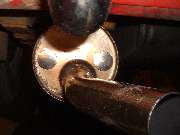
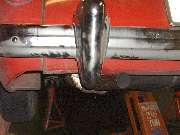
The general idea is to stuff the fiberglass in about as snug as is reasonable without working too hard. When nearly finished push the stuffing upward and downward inside to fill the voids at top and bottom. Then you can fluff it up just a bit to bring it back flush with the ports.
 Finish with installing the steel snap plugs. I would have preferred stainless steel snap plugs, but those would have been particularly expensive on special order. So I used plated steel snap plugs from the local hardware store. If they should go rusty by the time I get around to repacking again, they are dirt cheap to replace. These are the things used to close extra holes in an electrical box in your house, so look in the electrical department if they are not found in the hardware section.
Finish with installing the steel snap plugs. I would have preferred stainless steel snap plugs, but those would have been particularly expensive on special order. So I used plated steel snap plugs from the local hardware store. If they should go rusty by the time I get around to repacking again, they are dirt cheap to replace. These are the things used to close extra holes in an electrical box in your house, so look in the electrical department if they are not found in the hardware section.
It was only a minute to pull the wood blocks out and realign the muffler, and not 10 minutes more to reinstall the rear hanger (3 bolts). Properly hung back in place, no one would ever notice the snap plugs. In a few more minutes the tools were stowed and the car was off the stands and ready for the test drive. That turned out to be a pleasant drive around the neighborhood, when I could stop to chat with the neighbors without switching off the engine.
Switch on the radio if you have one, or chat with the passenger on the freeway without having to yell in someone's ear. The exhaust tone is now back to mellow and pleasant, same as when the muffler was new. The only question remaining is how long it might stay that way. I suppose I would be satisfied if the muffler makes at least 20,000 miles between repacking, vs. 40,000 miles between needing a replacement, and it should be easier next time. Relax, Moss Motors, you're off the hook. If this is the last sentence on the page, everything is still peachy with the repacked muffler, and I will report again if or when it needs more attention.
Addendum February 28, 2011:
Well, it wasn't the last sentence on the page. Bummer. Unfortunately the random packed fiberglass didn't last very long, maybe 8 months and 10,000 miles. If I ever had enough incentive I might try it once more with more vigor for tighter packing. As it turned out I put up with the noise for another year before I tore the car apart for body sill replacement. When it went back together it got another new stainless steel glass pack muffler. That one is still doing okay 1-1/2 years and 23,000 miles later. Have to give it a few more years to see what happens. It might last longer now that I'm not autocrossing so much and cut back considerably on trailer towing.
On Aug 28, 2022, John Harris in Liphook, Hampshire, UK wrote:
"Here's what I did. -
|
Buy several packs of stainless steel pan scourers. They look like thin ribbons of st st scrunched up into a ball the size of a golf ball. They're cheap as chips. You'll need quite a few - I think I used about 70.
Make a 1.5 to 2 inch hole in the front face of the silencer / muffler. Pack those scourers in pretty tight using a long stick to poke them into the furthest recesses.
Then make a cover plate in stainless with clearance holes for 5 or 6 small machine screws, and drill and tap the end plate to take them. Some exhaust sealing paste if you wish. Job done.
|
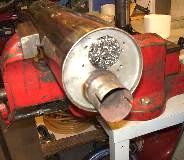
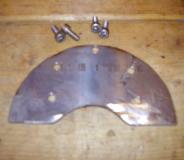

Unlike glass wool, they really can't go anywhere. Mine has been run for a few thousand miles with no change in the exhaust note over that time. It is as quiet as a new original item at low revs, but still gives the distinctive MGA rasp at 4000 rpm and above.
Downside - a bit heavier than standard - probably a pound or two. And a bit of work. And trouble if you steal them from the kitchen.
I doubt I'll ever match Barney's 40 000 miles but this has a better chance than repacking with glass". --
|